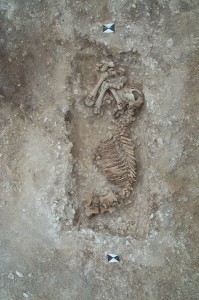From our occasional contributor Michael Kubisch.
Anyone who has seen Jurassic Park (and who hasn’t) will understand how this film has stirred the imagination by suggesting the possibility of bringing back species that have long gone extinct. Add to that the recent breakthroughs in our ability to retrieve and decipher genomes obtained from tissues of animals that have perished thousands of years ago and you can understand the excitement. Italian scientists now claim to have a rough draft of the genome of the aurochs, a wild bovid that roamed Europe until perhaps as late as the 17th century and which is depicted so beautifully in the cave paintings in Lascaux. With the genome map as a compass the Italians are convinced that they can now breed back the aurochs using contemporary cattle breeds as a starting point.
Such attempts are, of course, not new and there are bovids around that are thought to resemble the aurochs. But in the past such efforts were always fraught with a fair degree of uncertainty because they relied entirely on phenotypic information gleaned from drawings or written descriptions. Having actual genetic information of the aurochs takes that uncertainty out of the equation. Whether the Italians’ efforts will be more successful is hard to predict because they are based on the assumption that all of the genetic information of the aurochs can still be found somewhere in modern cattle. And it is far from clear whether that is the case. But even if it isn’t, having the aurochs genome at hand, it may one day be possible to make the necessary genetic changes to transform a modern cattle embryo into an aurochs embryo and have that embryo then carried to term in a modern cow. And if you can bring back the aurochs, it may quite well be possible to bring back animal breeds that have similarly vanished. Still sounds a bit like science fiction? Perhaps, but nobody ever thought you could clone a sheep.

Yes!!
A lot of companies are gonna go wild over this animal. We are breeding back the aurochs so we can kill it again.
It would be wonderful to correct some of our mistakes. Calling back into exsistance of lost parts of our enviroment and the relationships we had with them would perhaps make us more human. As parts of the enviorment that created us have been lost, some of the selective process that made us humans have also ceaced to operate. We are built to run, to listen, to hear, and yes, to hunt. We are not ment to sit endlessly set away from the natural world. In such closed places we become ill and die. Perhaps we will become helpless by simple selection. The Arouchs and creatures like it are physicaly and spiritualy good for man. The great beasts kept us alive and thinking. They made us aware, they made us able, and they kept us in awe. Is this not why we seek those who remain out for at least mere contact? In the native cultures I am aquainted with it is the great animals that have given rise to religon and social order.
We owe a debt to these beings. It is in our intrests to protect them and resurect them where possible. Resurecting to Aurochs would be homage and thanks enough.
My grandson called me last night he is a dinosaurus nut from the age of 2 he knows them all what they eat everything. He is nuts thinking you can bring them back with there skin and dna. By the way he is 12 years old. His nicknam is Dino man.
Recreating the form and function of the extinct Aurochs is important for the ideal placement of a key creature. Studies show, using Highland cattle , that a ten fold increase in flora and fauna is possible. While we are watching the fastest extinction process on the planet, our Diarmid cattle as recreated Aurochs offer an economical tool to perhaps slow down the extinction process.
We were the first to use three breeds or less to attempt form to function. Producing 13 colors. See National Geographic July 2010, our work not given attention? We were first with the concept following the Heck brothers, who used 18 breeds for their gene-pool. Blue Ox Farms 1989-2005, Minnesota. Our paper and site explained our process, the site 30,000- 60,000 hits per week. “The Blue Ox Express.” We were first to import Bazadaise products to the USA.